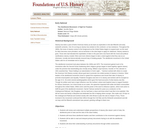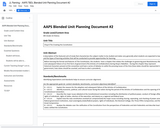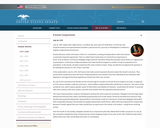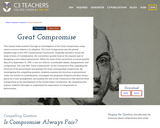
This parent guide supports parents in helping their child at home with the 8th grade Social Studies content.
- Subject:
- Social Studies
- Material Type:
- Reference Material
- Vocabulary
- Author:
- Kelly Rawlston
- Letoria Lewis
- Date Added:
- 10/12/2022

This parent guide supports parents in helping their child at home with the 8th grade Social Studies content.

This resource accompanies our Rethink 8th Grade Social Studies course. It includes ideas for use, ways to support exceptional children, ways to extend learning, digital resources and tools, tips for supporting English Language Learners and students with visual and hearing impairments. There are also ideas for offline learning.

In this lesson, students will: 1. Review and understand multiple perspectives of slavery (the slaves' point of view, the abolitionist point of view and the view of the slave holder). 2. Learn three abolitionist leaders and their contribution to the movement against slavery. 3. Read and interpret primary documents having to do with the abolitionist movement. 4. Demonstrate understanding of primary documents through written assessment.

Containing more than 50 articles from the award-winning Tar Heel Junior Historian magazine and over 40 lesson plans, this multidisciplinary Educator Notebook will enrich your exploration of North Carolina and American history with diverse perspectives. This resource's link takes you to a very short form that gives you free downloadable access to the complete PDF book.

Students will learn about the roles of African Americans in Congress during Reconstruction. Through their participation in class discussion and the review of primary sources, students will explore the political climate and changes that took place during Reconstruction. Students will focus on the legislation that restricted and advanced the rights of African Americans throughout this period, examining how African American men were able to gain representation in Congress. Through creation of and participation in a group teaching activity, students will focus on the important roles these African American legislators filled. Access the PowerPoint to accompany this lesson here: https://database.civics.unc.edu/files/2012/10/AfAmUSCongressReconstructionPPT.pdf

A website resource that provides facts and data that documents the forced removal of enslaved persons from Africa and their arrival to North Carolina.

Students will read and analyze historical documents and answer a series of questions based on their analysis.

Birth of a Colony explores the history of North Carolina from the time of European exploration through the Tuscarora War. Presented in five acts, the video combines primary sources and expert commentary to bring this period of our history to life. The accompanying teacher guides provide lesson activity ideas, vocabulary, and additional reading resources to compliment each act's theme. The 5 act themes are: First on the Land, The Road to Zacatecas, The Roanoke Voyages, A New Voyage to North Carolina, and , The Tuscarora War.

This resource contains information on the Compromise of 1877.

In this lesson, students will explain some of the issues faced by the delegates at the Constitutional Convention and describe how different states addressed these issues. Students will also be able to describe how the outcomes of the simulated Constitutional Convention compares to the outcomes of the actual event.

Witness the unfolding drama of the Constitutional Convention and the contributions of those whom we have come to know as the Founding Fathers. In this lesson, students will become familiar with four important, but relatively unknown, contributors to the U.S. Constitution Convention: Oliver Ellsworth, Alexander Hamilton, William Paterson, and Edmund Randolph.

Before learning the format and features of The Constitution, the students have a chapter that relates the challenges to governing post Revolutionary War and subsequent failure of our first form of government (The Articles of Confederation) during Shays's Rebellion. During this chapter they represent historical characters present at the convention and have a series of debates to settle the pressing issues of the time (how states should be represented in government, how slaves should be counted, and how to elect a president).

Students will analyze documents pertaining to the woman suffrage movement as it intensified following passage of the 15th Amendment that guaranteed the right to vote for African American males. Documents were chosen to call attention to the struggle's length, the movement's techniques, and the variety of arguments for and against giving women the vote.

Students will explore the Articles of Confederation and the Articles' influence in revising the Constitution of 1787. Students will experience the sentiments of Federalists and Anti Federalists by participating in a partner debate as either North Carolina Federalist James Iredell or Anti Federalist Willie Jones.

Fort Dobbs has created a series of short videos designed to teach students about the settlement of the Northwest Carolina backcountry, the lives of the Native Americans living in and near the region of Fort Dobbs, the life of a North Carolina Provincial Soldier, and North Carolina's role during the French and Indian War. The videos are designed for teachers to use them separately to fit into their own lessons or can be grouped together by theme.

This interactive site provides primary resources and curator interviews designed to focus on the lunch counter as an object in historical context. Also provided are a lesson plan and annotated links to other online resources to expand student understanding of the topic.

This resource tells the history of the Great Compromise.

Students will analyze a letter from President George Washington to the Governor of North Carolina regarding the state"™s stance on the new Constitution. They will then participate in a mock convention/debate to better understand the issues involved in ratifying the document. Finally the students will pretend they were at the Constitutional Convention as a reporter. The culminating activity will require the students to create a newspaper reporting on the various viewpoints of the Convention in a time-accurate periodical.

In this lesson, students analyze the history and the ongoing debate surrounding the resettlement of refugees in the United States and reflect on the plight of refugees both past and present and evaluate how the U.S. government's treatment of refugees has changed over time.

This inquiry leads students through an investigation of the Great Compromise using various sources related to its adoption. The Great Compromise was the pivotal breakthrough of the 1787 Constitutional Convention. By investigating the compelling question, students examine the structure of government under the Articles of Confederation, investigate two proposals (Virgina and New Jersey plans for a new arrangement, and analyze the role of the Connecticut Plan and the Great Compromise in the development of the United States Constitution. By completing this inquiry, students will begin to understand the importance of compromise in democracies.